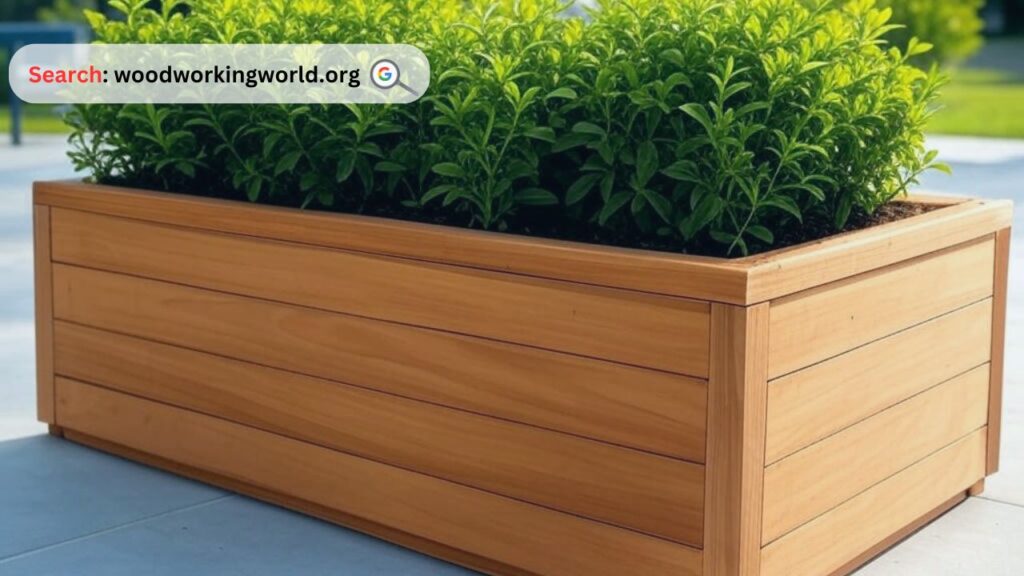Grow plants in style with a wooden rectangular planter! Discover creative ideas, DIY tips & top picks to elevate your garden. Click now to get inspired!
Wooden rectangular planters are a stylish and practical way to grow plants in various settings, whether on balconies, patios, or gardens. They offer a natural aesthetic, excellent durability, and can be customized to suit your needs. In this article, we’ll explore the benefits of using a wooden rectangular planter, how to build one step by step, and essential care tips to ensure longevity.

Why Choose a Wooden Rectangular Planter?
Wooden planters provide multiple benefits:
- Aesthetic Appeal: Blends seamlessly with outdoor and indoor spaces.
- Customizable: Can be stained, painted, or designed to match any decor.
- Eco-Friendly: Made from sustainable materials like cedar, redwood, or pine.
- Durability: With proper treatment, wooden planters last for years.
- Better Plant Health: Offers good insulation for root protection against extreme temperatures.
👉 Build 16,000+ Projects with Step-by-Step Plans—No Big Workshop or Costly Tools Needed! Start Now!
Step-by-Step Guide to Building a Wooden Rectangular Planter
Materials Needed:
- Wooden planks (cedar, redwood, or treated pine)
- Screws or nails
- Wood glue
- Drill
- Saw
- Sandpaper
- Measuring tape
- Wood stain or sealant
- Landscaping fabric
- Soil and plants of choice
Step 1: Plan Your Design
Decide on the dimensions of your planter based on available space and plant requirements. A common size is 36 inches long, 12 inches wide, and 12 inches deep.
Step 2: Cut the Wood
Using a saw, cut the wood into:
- 2 side panels (36 inches long)
- 2 end panels (12 inches wide)
- Base panel (36 inches by 12 inches)
- Optional legs if you want elevation
Step 3: Sand and Treat the Wood
Smooth rough edges using sandpaper and apply a wood sealant or stain to enhance durability and moisture resistance.
Step 4: Assemble the Planter
- Attach the side and end panels using wood glue and screws.
- Secure the base panel at the bottom.
- Reinforce corners for extra stability.
- If using legs, attach them at this stage.
Step 5: Drill Drainage Holes
Drill small holes at the bottom to prevent waterlogging and promote proper drainage.
Step 6: Line with Landscaping Fabric
Place a layer of landscaping fabric inside to retain soil while allowing excess water to drain.
Step 7: Fill with Soil and Plants
Choose nutrient-rich potting soil and plant suitable flowers, herbs, or vegetables.
Expert tips on Woodworking 🌿📦 Watch now!

Comparison Table: Wooden vs. Other Planter Materials
| Feature | Wooden Planter | Plastic Planter | Metal Planter |
|---|---|---|---|
| Aesthetics | Natural, customizable | Artificial, limited designs | Industrial look |
| Durability | Long-lasting with proper care | Can crack over time | Prone to rust |
| Insulation | Good for root protection | Poor insulation | Heats up quickly |
| Weight | Moderate | Lightweight | Heavy |
| Eco-friendliness | Biodegradable | Non-biodegradable | Recyclable but energy-intensive to produce |
Essential Maintenance Tips
- Seal and Stain Annually: Prevents wood from rotting.
- Avoid Overwatering: Protects wood from excessive moisture.
- Use a Liner: Extends the planter’s lifespan.
- Store Indoors in Winter: Reduces weather damage.
Best Plants for a Wooden Rectangular Planter
- Herbs: Basil, thyme, rosemary
- Flowers: Marigolds, petunias, pansies
- Vegetables: Lettuce, radishes, cherry tomatoes
- Succulents: Aloe vera, jade plant
A Relevant Quote
“Gardening adds years to your life and life to your years.” – Unknown
Frequently Asked Questions (FAQ)
1. How long does a wooden rectangular planter last?
With proper care, a well-maintained wooden planter can last 5-10 years or more.
2. What type of wood is best for a planter?
Cedar and redwood are excellent choices due to their natural rot resistance.
3. Can I use untreated wood for my planter?
Yes, but untreated wood is prone to rot. Applying a sealant extends its lifespan.
4. Do I need to drill drainage holes?
Yes, proper drainage prevents root rot and promotes healthy plant growth.
5. How do I prevent termites in a wooden planter?
Applying a non-toxic wood preservative and keeping the planter dry can help prevent termite infestations.

Conclusion
A wooden rectangular planter is a stylish, practical, and eco-friendly addition to any home or garden. Whether you buy or build your own, following proper care techniques ensures its longevity. With the right plants and maintenance, your planter will thrive for years to come. Start growing in style today!
👉 Click To Order Teds Woodworking With A 60-Money-back Guarantee From – Official Website